
As the media landscape continues to change, it’s important for PR pros to keep in touch with reporters and editors beyond pitching stories. Since the start of your PR career, you have likely heard about the importance of building relationships with journalists, and it is true. Your relationships with journalists are important —and should be treated as such.
Diane Harrington, Editor at Smartbrief, is a veteran communications pro and has seen it all—including the good, the bad, and the ugly. Our team had the chance to catch up with Diane to ask her the questions that keep PR pros up at night. We’re excited to have her share her knowledge and insights!
Can you share examples of successful collaborations or interactions you’ve had with PR reps?
I love PR reps who have a client list and ideas connected to each that they can share with me.
I’m also especially grateful when PR folks have “regular people” I can talk to—not just an edtech vendor or a random customer who happens to use your client’s product. More often than not, journalists want inputs on issues, solutions, and stories.
Writing about a new product on its own isn’t enough. Give me great, fresh story ideas and all the players I need to talk to, and I’ll be your friend for life.
I’ve also had a couple of PR reps be extraordinarily patient with me as I try to find time to work on a couple of articles. They occasionally ping me (no more than quarterly) to see if it’s still on my radar and they let me know if something new has happened in the topic area or with their client that may shape my piece.
Savvy PR reps also will pass along random info: “Hey, I hear you’re planning something on student mental health. I ran across the name of a great school psychologist—just wanted to share it in case they can help with your story.” That keeps your name in my mind. And when I tell people I’ll put something in my ideas and experts folders, I’m telling the truth: I really do have folders with those titles filled with emails that I like but that won’t work right now.
What are some common misconceptions reporters might have about working with PR folks?
I’ve been in the journalism/PR/marketing field for 40+ years. While I’m so grateful to run across savvy PR reps, too often I get a spam-style press release on a subject that’s far too general. It’s clear that it’s gone to 1,000 other journalists and that no thought has been put into how it will work for my publication.
Not all publications are alike, and many PR reps think, “Oh, let’s send this to all the education publications.” Read the reporters’ work for a while and figure out what makes them different, and tailor a pitch accordingly. If you know I don’t run press releases or articles on a product, take the time to create another formulaic press release that at least addresses that fact.
How can PR professionals best tailor their communications to meet the needs of reporters?
Give specific examples of how a product or solution can be used. Broaden your mind to narrow the story. Provide examples that haven’t been used everywhere else. That may be the secret to your success.
Are there any specific elements or information that you consider essential in a press release or pitch?
Like a good newspaper story: Who, what, when, where, why and how. But focus on which one of those is the most important to a given publication. Most PR reps know that my publication doesn’t print “new product” stories, new CEO stories, or events that are happening tomorrow in another state. If it’s in my city, or very nearby, that’s helpful. Otherwise, I need to be sent the information in a way that works for my publication. Or sent “In case you weren’t aware” for my files. Regardless, 99% of PR people send me the stuff I don’t need and can’t use.
What are some best practices for PR professionals to build positive relationships with reporters of any beat?
Don’t email incessantly. 95% of editors won’t respond to every email. If you don’t hear back, 99% of the time they’re not interested. Please do not email the reporter every day or two to follow up.
Try to convince your clients that it’s better to have sustained interest in them throughout the year—a story in this publication now, a story in another publication 3 months later, and so on. Rather than to have them all crammed into one or two months and then forgotten. The debut of a product doesn’t equate to a story. Think about the stories that you’d want to read about that product six months from now. Set up those circumstances: Ask the client if they can do a trial of it at a school so you can gather anecdotal information. Find out if they have already done one or have studies, etc.
0to5 Media Moments: October 2024In our blog series, Media Moments, the Zer0 to 5ive public relations team highlights a variety of media coverage secured by the team on behalf of our clients every month. Check back each month to see the team’s ongoing work.
In public relations, the ability to offer a variety of stories is critical to capturing the interest of journalists. These stories can range from funding news and product news to human-interest stories and interesting executive points of view.
Throughout October, the Zer0 to 5ive team worked diligently to place a range of features and mentions on behalf of clients.
Check them out!
CNBC Make It for UTI
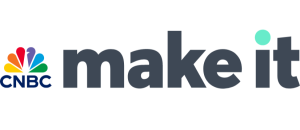
Promoting an individual’s story to highlight a broader trend can be a great way to tap into the national conversation. On behalf of Universal Technical Institute, Inc., the team pitched a story about a successful alumna from Concorde Career Colleges – the organization’s healthcare division – for CNBC’s “Ditching the Degree” series. Read the article here.
Axios for NWEA

Regularly proactively pitching experts who can discuss key topics in education can get you on the radar of reporters so that when they’re covering a related topic, they will reach out. After pitching education experts to Axios on behalf of education clients, a reporter reached back out to request a comment from an expert on the impact of severe weather on students and schools. The team was able to connect this reporter with a researcher from NWEA, resulting in a story quoting one of the organization’s researchers. Read the article here.
SiliconANGLE for Sony Innovation Fund

A new round of startup funding can be intriguing for journalists, especially if they are offered exclusively or under embargo. On behalf of Sony Innovation Fund and its portfolio company, Sidero Labs, the team leveraged an embargo strategy in advance of a funding announcement to generate interest from key journalists covering Kubernetes technology. This outreach resulted in a detailed feature by SiliconANGLE for the portfolio company, mentioning Sony Innovation Fund. Read the feature here.
The 74 Million for AERDF
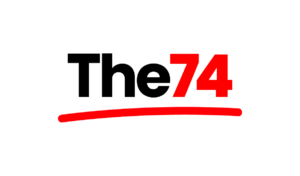
In an age when media outlets are looking for insightful content and points of view, it is helpful to work with clients’ experts to develop bylines and op-eds that can be submitted and published. The team worked with the Advanced Education Research and Development Fund (AERDF) to develop an op-ed for The 74 on the need for educator and community engagement and federal investment in education R&D. Read the piece here.
SD Times for Onymos
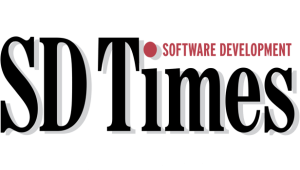
In the tech sector, news on enterprise software and products frequently captures media interest. Recently, the team utilized a major product update from Onymos to inform the tech trade media about the enhancements and advantages for enterprises using the product. This effort led to coverage in SD Times. Read the news here.
Fordham Institute’s Ohio Gadfly Daily for YouScience
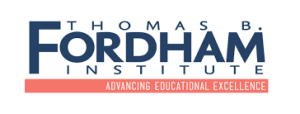
As a public relations team, we often can’t control where our media placements end up after their publication or who sees them. This is why we feel a great deal of excitement whenever an article we placed – whether it was months or years ago – continues to provide value and visibility for clients beyond its initial worth. Recently, the Fordham Institute’s Ohio Gadfly Daily highlighted YouScience, stemming from a feature that the team secured with a Fordham executive for Education Next two years ago. Read the mention here.
To learn more about how Zer0 to 5ive can help drive visibility and industry leadership for your company drop us a line.
5 Writing Tips for Technical Marketing ContentPutting pen to paper can be a daunting task, especially if your goal is to come up with content that will be both informative and enticing to your audience. Marketers have a difficult task of balancing catchy without being kitschy and providing enough information that a potential customer is intrigued enough to reach out for more.
Check out our top five writing tips for creating more engaging content:
1. Know Your Audience
Having a good grasp of who you’re writing for will help inform how you approach writing your technical documentation. Are you writing for direct-to-consumer products? Are you writing for a B2B audience? Once your audience is solidified, you can move onto establishing an effective voice and tone for your business.
2. Establish a Voice and Tone
Once you’ve figured out who will be consuming your content or viewing your website, you can decide how you want to talk to them. Are they a highly technical consumer, like a CIO or senior engineer? Are they a CMO or other marketing professional? These two audiences require very different voices and tones. A highly technical audience typically reads more serious and authoritative content that helps them get from problem A to solution B as quickly and efficiently as possible. For a CMO or marketing professional, a more friendly voice and tone may be warranted. Keeping your voice and tone consistent across all or your organization’s content – from blog posts to white papers – will also create a better user experience and overall satisfaction with your messaging.
3. Nail Your Format
The last thing to consider when creating technical documentation is what format is best for your audience. Is a blog post the best? A video? A powerpoint with lots of links to other resources? A key element to writing good content is presenting it in a way that people can consume it easily. Also, your format of choice will further inform the length of your document, if you should include illustrations or other forms of media, and if it can be printed or only viewed online.
4. Optimize for SEO
Having clear, concise, and informative technical writing helps search engines easily understand and index your content, improving its visibility in search results. Utilizing SEO tools such as SEMRush can help you get off the ground and inform the structure of your content. By incorporating relevant keywords naturally, using structured headings, and ensuring accurate descriptions of products or services, technical writing enhances user experience and search engine ranking. Well-executed technical writing also establishes authority in your niche, helping your content reach a broader audience while driving organic traffic.
5. Be Creative
Being creative with technical writing can significantly enhance your marketing efforts by making complex information more engaging and accessible to your audience. Instead of sticking to dry, overly technical language, incorporating storytelling elements, analogies, and relatable examples helps simplify complex concepts. Creative technical writing allows you to showcase your brand’s personality, connect emotionally with your audience, and differentiate yourself from competitors, all while conveying essential information. By striking a balance between accuracy and creativity, you can transform technical content into a powerful marketing tool.
Technical writing can elevate your marketing strategy by turning complex information into clear, engaging, and valuable content. By combining technical accuracy with creative approaches, users will have a better understanding of your company or product and you’ll improve your overall SEO performance, driving more traffic to your brand. Whether explaining products, services, or industry insights, effective technical writing positions your company as a trusted authority in the field, ultimately boosting engagement and helping to achieve your broader marketing goals.
Good luck, and happy writing!
0to5 Media Moments: September 2024
In our blog series, Media Moments, the Zer0 to 5ive public relations team highlights a variety of media coverage secured by the team on behalf of our clients every month. Check back each month to see the team’s ongoing work.
As a public relations professional, persistence and resourcefulness are crucial to achieving results for your clients. This might involve conducting regular touch bases with journalists to build strong relationships and stay updated on what they are working on. It may also mean leveraging a new piece of exploratory research to garner the interest of a particular journalist or following a specific news event to determine if there is a relevant opportunity for your client to provide a comment.
At Zer0 to 5ive, we work diligently to make things happen and use the points of view, content, and resources available to build stories journalists want to pursue and publish.
Learn more about how we secured some big wins for our clients in September.
Business Insider for Digital.ai
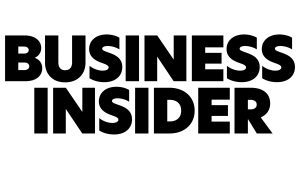
Patience and relationship-building almost always pay off. When conducting outreach on behalf of a client, you never know if it will align with what a journalist is focused on at that particular time. That’s why you must regularly check in with them to determine what they are working on, remind them of what your client can offer, and simply remain a trusted resource for them.
This tactic worked for our team recently on behalf of Digital.ai. After months of building a relationship with a Business Insider journalist, he finally contacted us to request a conversation with the CEO of Digital.ai to discuss how coding jobs will continue to change in big ways with AI. This opportunity resulted in the CEO being a key voice in an article on the topic. Read the piece here.
Dark Reading for Onymos

Monitoring the news – whether through local or national TV broadcasts, checking media outlet newsletters, or reading through social media – is an excellent way to identify immediate opportunities for your client to provide their perspective.
Our team leveraged and expanded the insights provided by Onymos‘ CEO regarding LinkedIn’s use of user data for AI training to engage journalists. As a result, his commentary was featured in Dark Reading. You can read the article here.
Traxion.GG for Sony AI

New, interesting research can be a gold mine for media opportunities. This summer, Sony AI‘s Gaming and Interactive Agents Flagship Project released new, exploratory research that introduces a super-human car racing agent whose sensor input is purely local to the car.
Considering the media’s past interest in the project group’s research, we shared this latest research update with select journalists. This led to an in-depth feature with Traxion.GG that included insights from one of the research authors. Read the feature here.
The 74 Million for NWEA

Pitching executives for their opinions to be published is a crucial strategy for amplifying thought leadership, expertise, and brand visibility. These executives possess unique insights and knowledge that enable them to offer a valuable perspective on industry trends, challenges, innovations, and more.
As such, our team pitched a comprehensive point of view from an expert at NWEA focused on literacy. This piece resonated with The74’s opinion editor, resulting in its publication. Read it here.
KSL-TV for YouScience
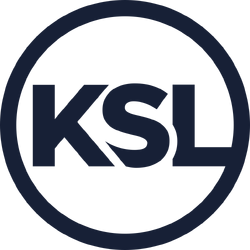
Television remains a powerful platform for building credibility, reaching a broad audience, and establishing thought leadership. After months of work with Utah’s KSL-TV on behalf of YouScience, the news station spoke with company experts and a student who has utilized the YouScience Aptitude & Career Discovery tool to guide her toward a career path aligned with her natural strengths to build an exciting segment for their nightly broadcast. The story told in the segment was also supported by recent YouScience data. Watch it here.
To learn more about how Zer0 to 5ive can help drive visibility and industry leadership for your company drop us a line.
Media Training: Lessons from the Greatest 80s and 90s HitsIn media relations, mastering the art of the interview is crucial for subject matter experts. It provides the necessary skills and confidence to communicate their message effectively, especially in high-stakes situations. Interview prep is vital given there are many factors to consider, ranging from understanding the story angle and media outlet to perfecting verbal and non-verbal cues that convey a friendly and confident demeanor.
What are the key aspects of media training?
Media training involves preparing spokespeople to communicate effectively, stay on message, and handle challenging questions with confidence. It’s not about scripting or controlling every word; rather, it equips individuals with techniques to stay calm, clear, and authentic, no matter the situation. Good media training ensures that key messages are conveyed clearly while avoiding common pitfalls such as oversharing or going off-topic.
It can be overwhelming to remember every interview tip while trying to convey your message effectively. That’s where the greatest hits come in: remembering song lyrics—they often stick in your head effortlessly.
So, let’s use a few 80s and 90s songs to help us recall the key aspects of media training:
“Don’t Stop Believin” by Journey – Believe in your message and stay confident during interviews. You are the expert, and while there are some – hopefully few – instances where some reporters will try and trip you up, most are just trying to gather the best and most interesting story possible.
“Under Pressure” by Queen and David Bowie – Handling tough questions with grace and always tying back to your top three messages is key to staying composed. Remember: If you don’t know something, don’t speculate. It’s fine to let a reporter know that you will get back to them later with the needed details.
“Express Yourself” by Madonna – Be clear and articulate when communicating your message. Keep in mind that some reporters might need more explanation than others on various topics.
“Take On Me” by A-ha – Be ready to tackle any question, even the tough ones. This is part of interview preparation. This can be in the form of a detailed briefing document or a mock QA that includes some tough potential questions.
“Rhythm Nation” by Janet Jackson – If you get off message, take a pause. Give yourself a moment to get back on a steady rhythm.
In the end, media training is about thorough preparation and understanding that you are there to tell a story. By channeling the timeless “lessons” from these iconic songs, you can turn every media interaction into a top-tier performance.
If you need media training, please reach out – “We will, we will, rock you!” (Queen, 1977)
The Importance of Creating Compelling Social Media ContentSocial media has become incredibly prevalent in our daily lives. From the moment we get up to when we go to sleep, we are constantly engaging with some form of online content. For B2B brands, this mindset should be no different. Social media has become an important tool that companies can use to showcase their offering, establish thought leadership, and engage with their target customers and prospects to build loyalty.
During my two summers as a marketing and social media strategy intern at Zer0 to 5ive, I’ve been involved in creating social media content both internally and for clients. In this blog, I’ll dig into best practices for social media research, content organization, and copywriting.
The Importance of Social Media Content for B2B Brands
Social media platforms are more than just channels for self-promotion; they are the bridge between companies and their customers. Everything from products and thought leadership to news announcements can be shared via social channels. Social media content helps B2B brands increase:
- Brand Awareness: Consistent and engaging content helps increase a brand’s visibility and recognition. It allows brands to share their story and value proposition with a broader audience.
- Brand Engagement: Social media offers a direct line of communication with customers. Engaging and educational content fosters interaction, builds community, and strengthens customer loyalty. Companies can engage in industry conversations, reshare articles of value and immerse themselves within their industry community.
- Brand Reputation: Through social media, brands can create and manage their image and respond promptly to industry trends and feedback. This proactive approach helps in building a trustworthy reputation with buyers and partners.
- Brand Preference: A strategic social media program can help create brand preference and also showcase momentum within the industry with customer case studies, original data, and educational content that provides value.
Writing Social Media Content
Creating social media content is a meticulous process that begins with understanding the company’s social media objectives. Once those are determined, a strategy can be developed that ensures content aligns with goals and fully leverages internal assets – from subject matter experts to white papers and reports.
Getting into the tactics of content creation, there are a few key steps to follow:
- Research: It’s important to research what’s being said in and around the industry you are writing for, especially when you’re looking to provide commentary on industry trends. Scouring X (Twitter) by searching through accounts and hashtags relevant to whatever client you’re writing for and conducting google searches on keywords is the best place to start.
- Content Curation: When looking for content that you can comment on related to industry trends, you should carefully review multiple articles. This not only helps with information gathering, but provides insight into different approaches brands are talking about and how you may be able to best provide additional color. You must also consider what your audience will find valuable and engaging.
- Drafting and Editing: Each post should be crafted to be concise, engaging, and aligned with the brand’s voice. It can be helpful to share your drafts with a team member for editing to ensure clarity and correctness if you have any doubts. This can also help you make sure that each post hooks the target audience, leaves an impact, and is error-free.
- Scheduling and Analysis: Once your post is live, you are able to track its performance. By looking at the performance of your posts over time, you can better understand what your audience engages with and appreciates. That allows you to continually refine your content strategy and test new approaches.
Creating social media content is both an art and a science. It requires you to immerse yourself in each brand. Social media is a powerful tool, and with the right strategy and execution, it can elevate a brand and leave a lasting impact – so much more than another click on LinkedIn.
To learn more about how B2B brands can win at other forms of content marketing, check out our previous blog on this topic!
This blog was written by our 2023 and 2024 summer intern, Espy Zelov.
0to5 Media Moments: August 2024In our blog series, Media Moments, the Zer0 to 5ive public relations team highlights a variety of media coverage secured by the team on behalf of our clients every month. Check back each month to get a glimpse at the team’s ongoing work.
During the summer months, public relations professionals historically face challenges in securing media opportunities and coverage. However, as news cycles and coverage continue to change, it is more important than ever for journalists to report the latest news and most interesting stories to their audiences. This shift has turned what used to be slow periods into opportunities.
This summer, we’ve observed a wide range of news and stories capturing the attention of journalists from different industries and outlets. These include topics that are interesting to journalists, such as those related to trending subjects and data, as well as access to high-ranking subject matter experts or executives.
See which topics resonated with the media in our August highlights.
CNBC Make It for Universal Technical Institute, Inc.

Pitching an individual’s personal story is a great way to grab media interest in a topic or trend. In response to rising interest in the skilled trades among Gen Z, our team pitched an interview with a recent graduate of Universal Technical Institute to CNBC. This outreach resulted in a story about the graduate and how going into the skilled trades positively impacted her life. Read the story here.
TechRepublic for Onymos
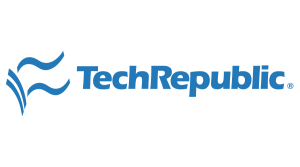
Journalists are always looking for new and exciting data that can be connected to broader trends or uncover fresh insights about a specific industry. They are also interested in obtaining this data exclusively or under embargo so that they can be among the first to report on it. That’s why our team conducted embargo outreach to a select list of outlets before releasing Onymos‘ SaaS Disruption Report: Security & Data. This approach enabled us to secure coverage with TechRepublic, which was published on the day of the report’s release. Read the article here.
EdWeek Market Brief for HMH

The most impactful interviews are with executives or subject matter experts who can dig into various trending topics, demonstrating the depth and breadth of their expertise and knowledge. In fact, such interviews often lead to multiple opportunities for further discussions or the creation of several articles covering different aspects of the topics discussed. This can be exemplified by an EdWeek Market Brief article featuring HMH, which resulted from a conversation the organization’s CEO had with the journalist earlier this summer. Read the article here.
Design News for Nauto
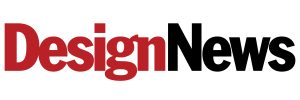
By highlighting the background of a subject matter expert or executive, we can demonstrate why they are a valuable source for current events and trending news topics. This is an effective way to secure coverage for a client, especially considering the ever-changing nature of newsrooms and their coverage. As a result of previous relationship-building and accurately demonstrating an expert’s knowledge and point of view, our team secured coverage for Nauto with Design News on autonomous vehicle systems. Read the article here.
eSchool News for AERDF, HMH, NWEA, SchoolStatus, & YouScience

Many schools across the country start heading back to school in August. This leads the education media to develop stories about what to expect in the upcoming school year. For these stories, journalists seek predictions from academic experts, researchers, and education technologists. Our team leveraged the insightful thoughts from AERDF, HMH, NWEA, SchoolStatus, and YouScience in August to secure coverage with eSchool News. Read our clients’ education predictions here.
To learn more about how Zer0 to 5ive can help drive visibility and industry leadership for your company drop us a line.
Left in the Dark of Slow News? PR Is a Lightswitch Always Left On!Whenever a client signs on for PR support, the ultimate goal is to obtain media coverage. For many types of clients, especially startups, “hard” news, which is the gold standard for connecting with reporters, is sporadic at best. In this case, media coverage is best achieved through proactive pitching, such as thought leadership interviews or byline placements.
When slow times happen – the dog days of summer are a big one! – clients still want results, and it’s our job to make it happen no matter what.
Let’s dig into a few ways that you stay proactive and productive when news is nowhere in sight.
Never Stop Proactive Pitching!
While this seems obvious, PR folks should be pitching constantly, especially when their clients’ announcement pipeline is slow. Trying out new and different angles or repurposing pitches that worked in the past (near-term) are a few places to start. Discussing byline ideas with your client that can be drafted for or placed exclusively in specific target outlets is also something to consider. Another idea to chat with your client about is the availability of customers who are interested in speaking to the media. If there are one or two available, their perspective and stories can unlock a host of new opportunities. Lastly, some clients are always looking to expand their vertical presence, so it’s always worth checking if there are new topics they want to put a stake in the ground on or discuss a particular trending issue. Being diligent about pushing your client to explore all areas of opportunity can open the floodgates of opportunity and help you build new relationships on their behalf.
Conduct Rapid Respond All the Time!
Is your client keen on sharing their perspective at any time on relevant topics flooding mainstream media? Did that hot news item that dropped this morning have a direct tie to your clients’ offering? There is always a time and place for rapid response. Even when there isn’t a big disruptive event on which to comment, you should always have a list of keywords in your alerts – Google Alerts and Talkwalker are both great – to track news happenings in real-time. While you may not secure an opportunity every time, this is a great opportunity to offer your client as a source to more reporters than you might typically hit with a general proactive pitch. It can also open doors to key media outlets that have been a struggle to break into.
For more on rapid response, check out our blog on the topic.
Pitch a Podcast!
Over 4.1 million podcasts currently exist, so there is a good chance your client could be a guest expert on one of them. What’s great about podcasts is that a lot of the time, while the episodes are topical, they are often evergreen, so pitching your client for a guest spot could come immediately or a month down the line. Any time, though, is a good time to participate.
A few things to consider:
- Your clients’ target media outlets may have an associated podcast, which is an excellent place to pitch your client. These outlets may even do a write-up alongside the podcast, which is a fantastic double hit.
- Some independent podcasts are run by industry thought leaders or influencers. This is a nice way to get your client in front of an audience that should know about your business/offering/product but also gives you the chance to showcase your clients’ industry expertise with their peers.
- There are podcasts run by industry organizations. If your client is part of one, has an interest in becoming part of one, or the organization takes perspectives from outside sources, this could be a great way to showcase your client within the organization’s community.
Don’t Forget Ed Cals!
Editorial calendars are becoming less relevant these days due to the fast-paced nature of the news and industry conversations. However, top-tier outlets like the Wall Street Journal and Forbes still rely on them. It’s imperative that PR people are aware of topics these outlets plan to talk about – it gives them a leg-up on the planned features that clients might have a shot at being included as a source. A bonus is that ed cal topics may be featured both online and in print – so that’s double the coverage!
We wrote a blog on ed cals, too, so check it out for more info.
Create DIY News!
Simply put, there are always opportunities to make news for your client to share. Think about previous announcements or company milestones they might not have promoted externally. This could be anything such as sales metrics, growth metrics, client wins, product announcements, new hires, and award wins. A few of these put together and you’ve got a momentum release! These updates can garner interest from trades and possibly uncover interview opportunities to discuss updates to where the company is heading.
If your client doesn’t have access to its own internal data, working with them to produce a consumer or business survey can also be a news generator. This entails using a platform like Pollfish or SurveyMonkey to ask questions that are directly related to a theme your client wants to own. Once the data is available, putting it into a nice report with a snazzy headline can be a game-changer when trying to pitch your client to national media. They love strong data – and even just one point can help them create a new story or bolster an existing story.
Leverage Your Relationships!
If you have been working with a client for six months or more, chances are you’ve created media relationships along the way. Even if you are already constantly proactively pitching them, you can always email your contacts to see what they are working on and if your client can provide any color to stories they are working on. While it may not always pan out, at the very least, it’s a simple way to keep your client top of mind without being too pushy.
The media can be fickle, but reporters are always hungry for content, and you will never know what they are working on. It’s important to keep your client in the loop – always be pitching, leverage your relationships, create newsworthy moments, and think outside the box. This will help you keep an edge in the fast-paced media landscape.
To learn more about how Zer0 to 5ive can help drive visibility and industry leadership for your company drop us a line.
0to5 Media Moments: July 2024In our blog series, Media Moments, the Zer0 to 5ive public relations team highlights a variety of media coverage secured by the team on behalf of our clients every month. Check back each month to get a glimpse at the team’s ongoing work.
There are many different ways to generate media coverage on behalf of clients – from news announcements, thought leadership, and customer stories, to data reports and meeting with reporters at events. All, though, require a good story and patience to see the coverage through.
Our media features and inclusions in July resulted from outreach efforts leveraging data, industry trends, news, and customer stories. Check them out below!
The Washington Post for NWEA

Journalists love reporting on stories that have data to back up industry trends. Since 2020, NWEA has released many reports tracking students’ academic progress since the start of the COVID-19 pandemic. NWEA continues to share insights into how students are doing compared to their peers and highlight interventions that can best support learners. Timing is everything, so our team used an embargo approach to share the newest data-backed trends with The Washington Post. Read the article here.
K-12 Dive for AERDF
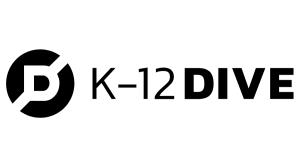
Stories with real-world impact are appealing to journalists, especially if you are able to connect them with outside sources to give different points of view. On behalf of the Advanced Education Research and Development Fund (AERDF)’s EF+Math Program, 0to5 pitched a story about an innovative program that is helping students learn math while having fun. The story, which features Fraction Ball, includes photos, a video, and perspectives from multiple sources, which helps capture the impact of the program. Read the story here.
VentureBeat for Nauto

Sometimes, patience is key when looking to nail the right story for your client. Nauto, a provider of AI software for driver and fleet safety, began its dialogue with VentureBeat during CES in early 2024. While scheduling challenges were present, the team remained persistent, and was able to facilitate a ride-along with the reporter to witness the Nauto tech in action, resulting in a full feature article. Check it out here.
Forbes for YouScience

National data garners national attention. YouScience, the leading technology provider dedicated to solving the skills gap crisis for students and employers, released their annual “2024 Female Students and STEM Report,” which resulted in an article offering strategies for increasing STEM career exposure for female students. Check it out here.
Diginomica for Onymos
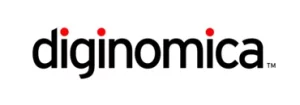
There are always opportunities to reconnect your clients with reporters that have covered them previously. From backgrounders to commentary on industry trends, building a rapport of consistent, timely and thoughtful interactions is how reporters establish their go-to sources. 0to5 reconnected Onymos’ CEO with diginomica to discuss how no-data architecture is changing the software landscape, which resulted in a feature piece on the topic. Read about it here.
To learn more about how Zer0 to 5ive can help drive visibility and industry leadership for your company drop us a line.
How B2B Brands Win at Content MarketingMarketing has taken a major shift over the last several years. No longer confined to traditional methods, businesses are now leveraging content marketing to engage with their audience, build trust, and drive sales.
For B2B brands, this shift is not just a trend but a necessity. When it comes to marketing for B2B companies, content marketing focuses on delivering high-quality, strategic content that resonates with potential customers, addresses their pain points, and positions your organization as a thought leader in your industry.
Unlike traditional advertising, content marketing aims to provide useful information that educates, entertains, or inspires. This content can take various forms, including blog posts, white papers, eBooks, infographics, videos, podcasts, and social media updates.
Content Marketing vs. Advertising
Content marketing and advertising are two distinct strategies that serve different purposes but that support the ultimate goal of engaging prospects.
Content marketing is used to attract, teach, and entertain your audience with valuable, relevant content. It focuses on creating and sharing information that your audience finds helpful, which builds trust and positions your brand as an industry leader. In fact, 80% of all searches are for information intent, which is where your content marketing comes into play. We are seeking to answer the questions our audience is asking.
Advertising, on the other hand, relies on paid media to deliver quick, often immediate results. It works by distracting or interrupting your audience’s activities with promotional messages designed to capture their attention and prompt action. Advertising can be highly effective for new brand establishment and driving rapid engagement.
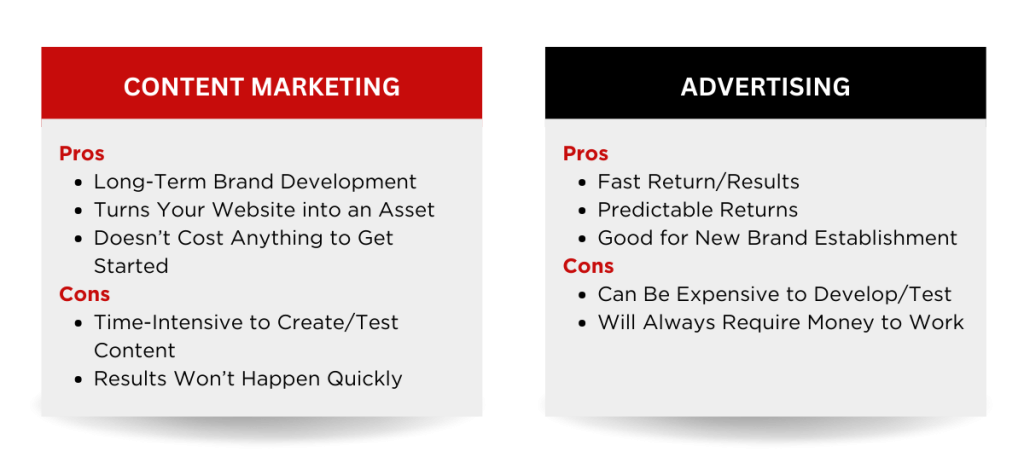
So, which one should you be using? Both of course!
You need paid advertising to get your brand, product, or service on the market. You need content marketing to create a deeper brand image that can eventually become a valuable resource to your customers.
Creating Your Content Strategy
There are 4 key steps to creating a content strategy that will help put you ahead of your competitors.
- Create Your Content Marketing Mission Statement
Your marketing mission statement is the reason why your audience should care. The three elements of your content mission statement include: Audience X + Information Y + Benefit Z To break this down even further, your content is going to be everything you create. You are creating content for audience X on the topic of information Y, with benefit Z being the reason they should care. Only 28% of marketers have documented their content mission statement, but it is proven time and again that those who document theirs succeed more than those who do not. - Develop Original Research
Two types of content that resonate best with audiences are original research and strong opinion pieces. Original research is accessible to anyone and involves finding and answering industry-specific questions or uncovering missing statistics. What is the answer your audience is seeking? Chances are if you are searching for the answer, someone else is too. - Repurpose Your Content
Consider repurposing your content mission statement into a powerful website, social media, or email marketing CTA to drive engagement. You can also repurpose any content you create into various materials. Consider a report you spent a lot of time working on – you don’t want to just end there. The data is in your hands! Turn the report into an infographic, write a press release, draft a social post, and send it out in an email blast. - Collaborate with Other Creators
Collaborating with influencers to create content with their input naturally attracts links and authority. Pitch this content to editors, media outlets, and industry blogs, and offer to rewrite your content from different perspectives to enhance originality, such as turning “5 Tips to Keep Your School Safe This Year” into “5 Mistakes Schools Are Making When It Comes to Student Safety.” Don’t forget to link back to the original piece to boost your authority score.
Digital Content and SEO Best Practices
There are many tools available to help you get started on your content creation journey, including:
- Google: The best source to search keywords and see what’s showing up; Google Suggest/Autocomplete allows you to see what your audience is searching
- SEMRush: Its topic research tools give you ideas for subjects to write about and also include keyword research for you to apply in your content itself
- Quora: A Q&A social platform where answers can be upvoted and help provide you with the content to answer these questions
- Answer the Public: Plug in a topic, and it will give you questions that it scrapes from the internet
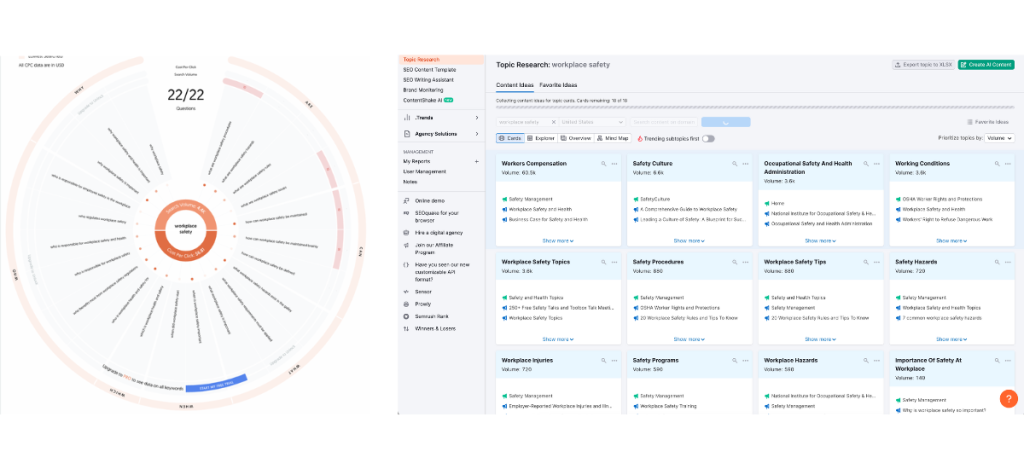
Creating effective headlines for your content is key to attracting visitors; a headline that fails to catch the reader’s attention will simply be ignored. Visitors conduct a quick cost-benefit analysis before deciding to click, so it’s essential to use wording that immediately demonstrates value. When optimizing for search, be sure to meet people’s expectations and stay relevant, while on social media don’t be afraid to be a bit unexpected.
When crafting the perfect headline, be sure to start with your keywords – this is known as keyword prominence – and ensure your headlines are tailored appropriately for each channel. Google search favors titles with questions, while 11-word headlines perform well on social media. However, when it comes to articles, 14+ word headlines tend to get 3x more traffic, 2x more shares, and 5x more backlinks.
Beyond headlines, formatting your content to keep visitors engaged is key. Your audience isn’t reading everything, so huge, blocky paragraphs don’t work. Break up the text to enhance readability and maintain a smooth flow down the page. Don’t forget to link to other relevant content or pages across your website, as internal links not only keep visitors exploring your site but also improve your website’s SEO.
Bringing It Into Practice
In today’s competitive landscape, content marketing continues to be a powerful tool for B2B brands. By constantly offering valuable insights and solutions, you can nurture relationships with potential and existing customers, guiding them through the buyer’s journey and ultimately influencing their purchasing decisions.
Unlike traditional advertising, content marketing builds trust and authority over time. While it may require patience and effort to create and test content, the long-term benefits of establishing a strong brand presence and fostering customer loyalty make it a worthwhile investment.
To learn more about how Zer0 to 5ive can help drive visibility and industry leadership for your company drop us a line.
